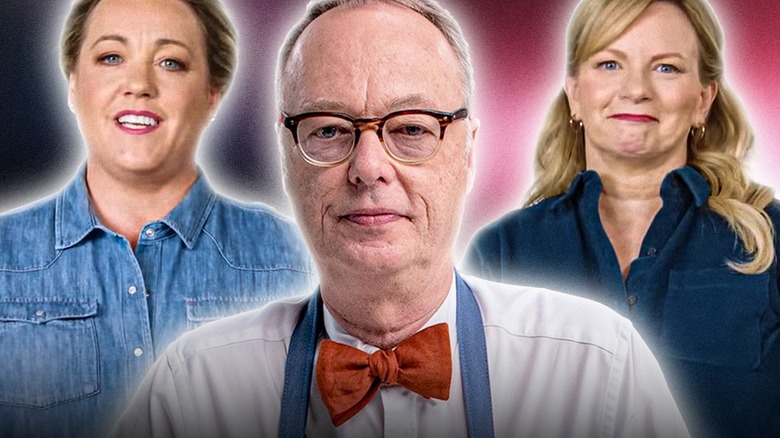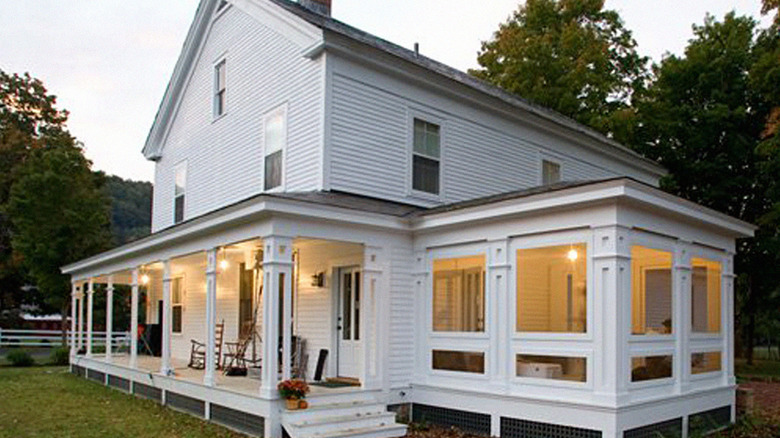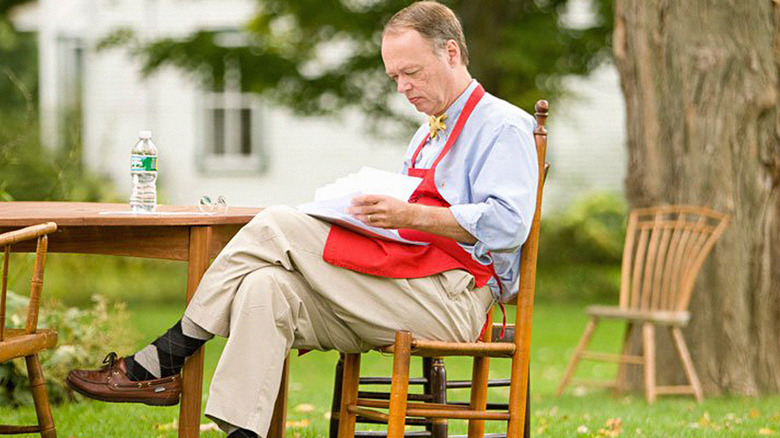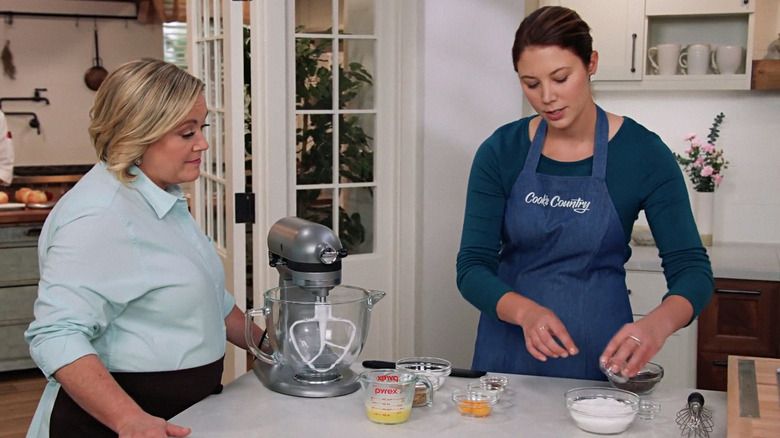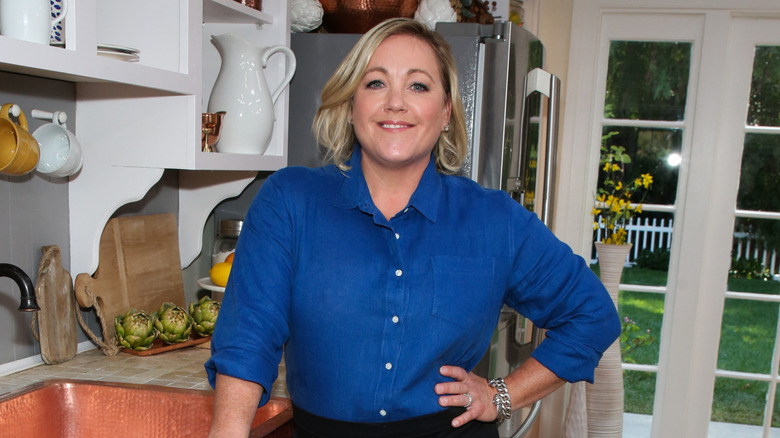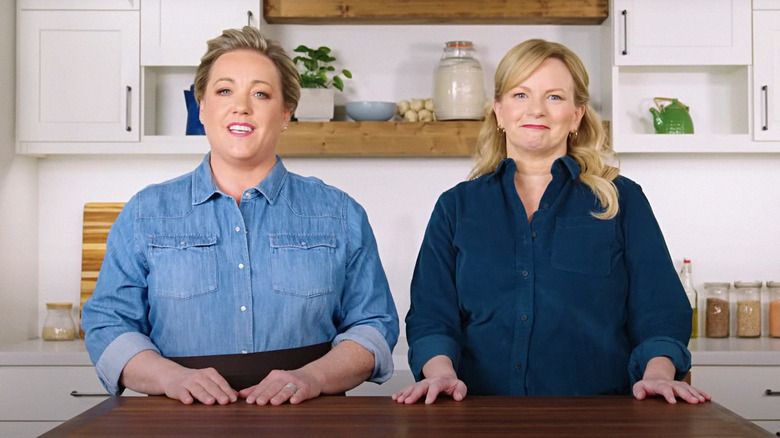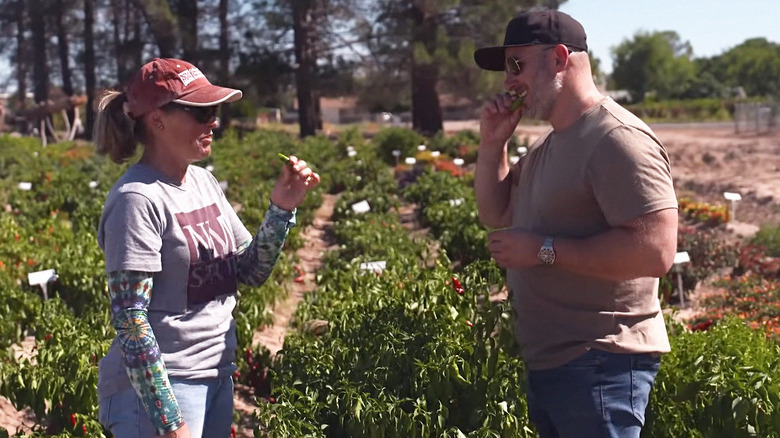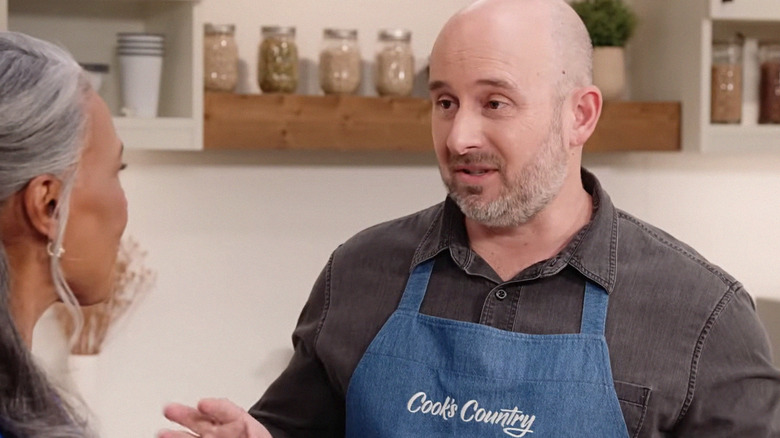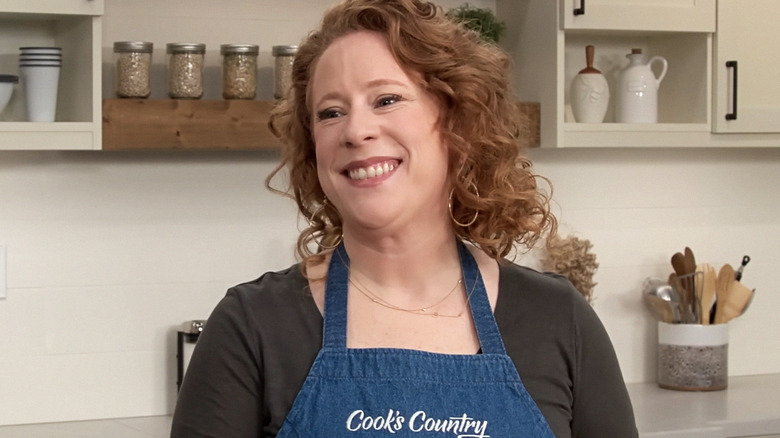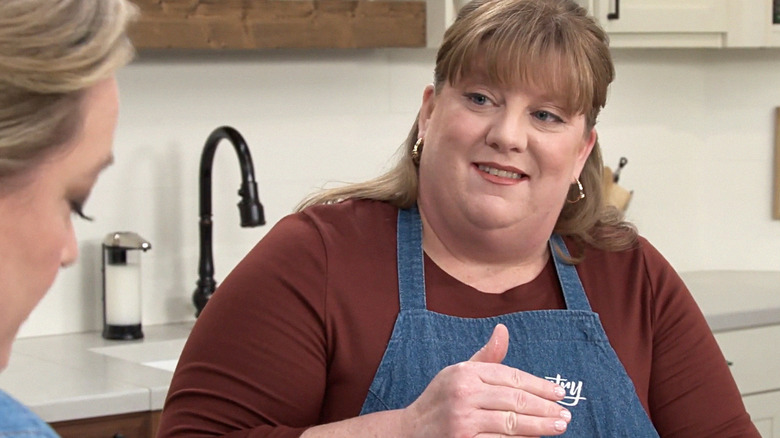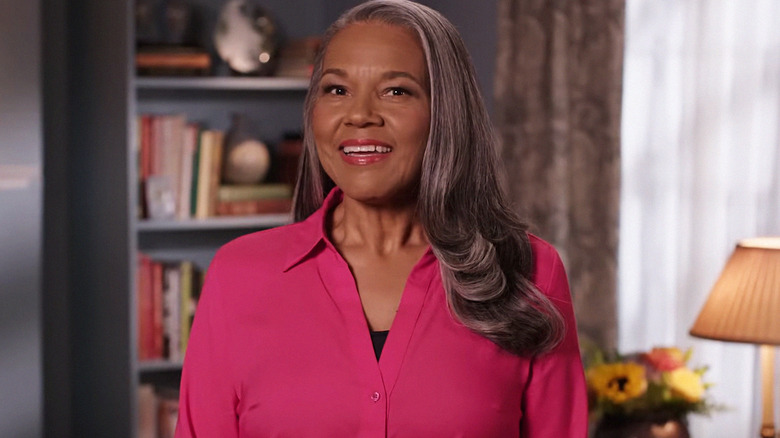Behind-The-Scenes Facts About Cook's Country Revealed
America's Test Kitchen is a sprawling multimedia project, consisting of multiple magazines, podcasts, spin-off series, and more. Chief among those spin-offs is "Cook's Country" — or technically, "Cook's Country TV," to differentiate it from the identically titled magazine that inspired it. Whereas most spin-offs, like "Julia at Home" or "Today's Special with Ashley Moore," are web-only, "Cook's Country" is the sole additional component of the America's Test Kitchen empire to air on traditional TV.
While "Cook's Country" is similar to "America's Test Kitchen," in that it spotlights many of the same chefs walking viewers through rigorously tested recipes, what sets it apart is a narrower focus on regional American specialties. Of course, even if "Cook's Country" is simple in concept, there's a lot more going on behind the scenes than might be immediately apparent. After all, no TV show makes it to 17 seasons and counting without a whole lot of hard work. For both prospective viewers new to the world of "America's Test Kitchen" and seasoned fans alike, here's some insight into just what goes on behind the scenes of "Cook's Country." Or put another way, the following are all key ingredients in the recipe behind the show responsible for some of your favorite recipes.
Originally, 'Cook's Country' was filmed in an actual Vermont farmhouse before briefly moving to a replica set
Beginning in its earliest seasons, one notable element that set "Cook's Country" apart from "America's Test Kitchen" was its setting. Whereas the latter series filmed in what looked like the kitchen of a large urban home, "Cook's Country" utilized a comparatively folksier farmhouse. While it's entirely feasible that the show might have incorporated an establishing shot of the farmhouse's exterior before shooting in a visually similar studio, the farmhouse in the "Cook's Country" opening sequence actually served as the show's set for its first nine seasons.
In fact, original host Christopher Kimball purchased and owned the home, located in Rupert, Vermont. Nowadays, the building is available to rent on Vrbo, albeit under new ownership. By Season 11, "Cook's Country" changed shooting locations, moving into a massive space shared with "America's Test Kitchen." For just one season prior, however, "Cook's Country" filmed in a kitchen fabricated to replicate that of the Rupert, Vermont farmhouse. "In the transition period after Chris Kimball left, we shot one season," chef Bryan Roof told KLCS. "We rebuilt that set in the sound stage so it wouldn't be too shocking to the viewers because we had new hosts, Bridget [Lancaster] and Julia [Collin Davison], so we wanted to keep the set the same."
At least in its early days, a single 'Cook's Country' season would shoot in just 2 weeks
After moving out of its original Vermont farmhouse location, the precise amount of time it takes to film a season of "Cook's Country" is not a matter of public record. Because "America's Test Kitchen" owns its own studio space, the show should technically be able to film whenever necessary. In its Vermont farmhouse days, however, a full 13-episode season of "Cook's Country" would wrap filming in approximately two weeks.
Of course, the total amount of time it would take to complete each season was considerably longer. Even before tacking on time for post-production, just perfecting the recipes the cast would then showcase in the Vermont kitchen took months of prep work beforehand at the "America's Test Kitchen" home base in Boston. While presumably pretty hectic, those two weeks in Vermont sort of doubled as a vacation, as Bryan Roof explained to KLCS. "We'd have these little parties at night in our rented houses. It was a great time," he said. Some 2010 set videos on original host Christopher Kimball's WordPress blog support this, in one case revealing a lemonade stand the "Cook's Country" crew seems to have built just for the sake of a comedy bit.
'Cook's Country' started filming inside the historic Innovation and Design Building in Boston as of Season 11
After Season 10 took place in a studio replicating the Vermont farmhouse's kitchen, Season 11 of "Cook's Country" marked the debut of a brand new set located in Boston's Innovation and Design Building. "America's Test Kitchen" announced that it was relocating its home base in late 2016, and the new space debuted just two years later when "Cook's Country" Season 10 premiered in August of 2018.
The Innovation and Design building was first built in 1918 by the U.S. Department of Defense as a storage facility for military goods. The building remained a military asset through 1983, at which point it was purchased by the city of Boston. Then in 2013, a private company called Jamestown L.P. bought and restored the 1.4 million square-foot space. One of the building's preeminent tenants is the Boston Design Center, responsible for 350,000 square feet of showrooms showcasing a wide variety of luxury home products. Other tenants with which "Cook's Country" shares the space include Reebok, Autodesk, and the Boston Beer Company.
A single five-minute recipe takes exponentially longer to shoot
A typical episode of "Cook's Country" showcases a few different chefs, each with their own recipe, resulting in roughly 25 minutes of footage. In 2019, the official "Cook's Country" blog published a first-person account of one particular day that magazine editor and TV runner Alli Berkey's spent on the "Cook's Country" set. As she recounts, even just a single five-minute recipe segment can take hours to film.
"Thin and Crispy Chocolate Chip Cookies debut time. We work through this recipe scene by scene," wrote Berkey, with a 10 a.m. timestamp. "It's much slower than you'd imagine — it takes about 15 to 25 minutes for each scene depending on how much the recipe entails." While the total number of scenes this particular recipe required is erroneously excluded from the piece, the completed segment on YouTube appears to consist of at least 10 distinct scenes. Based on subsequent timestamps included throughout the article, filming the Thin and Crispy Chocolate Chip Cookies recipe lasted through 11:45 a.m. or so, culminating in just under two hours of filming for about five minutes of footage. Complicating matters even further is the fact that some segments require reshoots, in which case a single recipe could exceed two hours and require multiple days of filming.
Longtime host Christopher Kimball's departure led to a lawsuit
Most existing fans are likely aware of the departure of franchise face Christopher Kimball from "America's Test Kitchen" and "Cook's Country" in 2015 over a contract disagreement. What complicated that departure was a legal dispute that lasted for years afterward.
In short, "America's Test Kitchen" filed a lawsuit in 2016 alleging that Kimball breached his former employer's trust upon launching a new brand called "Milk Street." According to the lawsuit, the alleged harm was twofold: Kimball purportedly utilized proprietary assets available to him while still employed by America's Test Kitchen to start up his new company, in addition to modeling "Milk Street" directly on the "America's Test Kitchen" model — consisting, notably, of both a magazine component and a TV component from its inception. In response, Kimball alleged that the lawsuit qualified as defamation against his character. Finally, in 2019, the two parties reached a resolution. While Kimball was required to sell shares he retained in the "America's Test Kitchen" brand back to the company, he was allowed to persist with "Milk Street," which remains active to this day. Even if "America's Test Kitchen" was never the same after Kimball left, both it and "Cook's Country" managed to persist and even develop new identities in Kimball's wake.
'Cook's Country' chefs regularly eat the dishes they make on TV at home
One factor that sets both "America's Test Kitchen" and "Cook's Country" apart from some of their competition is that they intend for the recipes they showcase on-air to be as practical as possible for non-professional chefs to replicate at home. With that said, multiple "Cook's Country" chefs are on record sharing that some of the recipes they've featured on the show have become staples in their own homes, suggesting it is common for "Cook's Country" chefs to practice what they preach.
Christopher Kimball, for example, told celebrity gossip blog Oh No They Didn't! in 2009 that he frequently prepared "Cook's Country" recipes at home around that time. "I like those recipes," he said. "We don't really do a lot of fancy cooking."
Longtime test kitchen cook and on-air personality Julia Collin Davison likewise recounted to KLCS how one particular "Cook's Country" recipe became a signature dish that her family started expecting her to prepare with regularity. "There was this recipe, and I was dragging my heels, it was for Caesar Green Bean Salad. I was thinking this is the worst," she said. "Then we made it and we ate it. It was one of the best green bean recipes I've had in years. It is now requested by my family all the time, I'm now required to make it for all holidays."
Julia Collin Davison and Bridget Lancaster worked together long before hosting 'Cook's Country'
Julia Collin Davison's professional relationship with Bridget Lancaster is grounded in a genuine friendship that's apparent whenever the two of them are on-screen with one another. After Christopher Kimball's departure from the America's Test Kitchen brand, Davison and Lancaster debuted on Season 10 as the new co-hosts of "Cook's Country," having long previously worked as test cooks. As it turns out, their working dynamic dates back not just to their days preparing food for "America's Test Kitchen" and "Cook's Country," but to the late 1990s, before the premiere of either TV series.
Lancaster joined the company first — which at that point would have been Cook's Illustrated magazine — in 1998. Davison followed in 1999. Upon Lancaster's addition to the Cook's Illustrated team, she was one of just three chefs in the company's famous test kitchen. When Davison joined the following year, the team was still presumably pretty small in number. Accordingly, Davison was one of the first chefs to appear on the "America's Test Kitchen" TV show when its production kicked off in 2000. The signature dynamic between Lancaster and Davison, then, is something they've honed for decades, beginning when they were both part of an exponentially smaller company, and leading them to become two of its preeminent personalities.
Bryan Roof's idea for his travel segments started out as a joke
Chef Bryan Roof ended up becoming one of the major players on the "Cook's Country" TV series as it morphed and developed a new identity in the wake of Christopher Kimball's departure. A typical Roof recipe is not just dedicated to a given dish's preparation but its significance to a locale Roof visited while traveling as well.
In an interview with KLCS, Roof revealed that his work on these travel-based recipe segments emerged from what was initially a joke. "It was kind of a joke that was floating around a meeting, 'We should get an RV and travel around the country and find food, eat them firsthand before we start cooking them,'" he said. "We laughed about it and a few months later, we had another editorial meeting and our boss at the time was like, 'Where are we at with the RV?' (laughs) We're like, 'Oh, you're serious!'"
For what it's worth, this went down while Roof was the food editor for Cook's Country magazine, prior to his televised work. Nevertheless, while Roof initially traveled just for print articles, those trips are what ultimately manifested in his travel segments on the "Cook's Country" TV show.
During his research, Bryan Roof never asks chefs outright for recipes, but hopes they'll share them voluntarily
When Bryan Roof showcases a recipe on "Cook's Country," it's something he learned from a chef he met while traveling, rather than, say, his own unique approach to a regional dish. In his interview with KLCS, Roof revealed that he receives permission to share each of those recipes without even having to ask.
"I never ask anybody out right for their recipe," he said. "Usually people are cool. There's two types of people and 95% of the people are like, 'Here's my recipe, here's what I do, if you want to share it with the world, that's great.'" That other 5%, however, worry that televising a proprietary recipe will hurt their business. For what it's worth, all of the subjects of Roof's research are well aware that he's preparing for a TV show, so they most likely know from the get-go that he's intending to showcase one of their recipes on TV even if he doesn't say so explicitly. Still, his approach helps ensure that the recipes he spotlights are not coerced out of his subjects but rather shared with enthusiasm.
Ashley Moore isn't just an accomplished chef, but a trained actor too
Alongside Bryan Roof, Season 10 of "Cook's Country" — the first without Christopher Kimball — saw the debut of chef Ashley Moore as an on-camera talent. In a manner similar to Roof's career trajectory, Moore had worked for "Cook's Country" for years prior, helping develop some of the recipes that ended up on air. That said, she was a natural fit for the TV show's cast, not just because of her skill in the kitchen but her background as an actor.
When it came time for Moore to attend college, she told The Day – a newspaper based in her hometown of New London, Connecticut — her intent was to pursue acting. Therefore she decided to study her chosen craft at the California Institute for the Arts. Once she graduated, however, she realized her interest in a culinary career. "I was aiming for the Food Network," she said. "My dream was to be on a cooking show." Soon she was interning for iconic TV chef Emeril Lagasse, but she ultimately decided to back out of food entertainment and work in the non-televised food industry. Eventually she split the difference, working for the magazines under the America's Test Kitchen umbrella for a time. After a few years she ended up on the brand's YouTube channel, finally culminating in her work on the "Cook's Country" TV show.
Christie Morrison taught English before becoming a culinary instructor for 'Cook's Country'
Christie Morrison debuted as a chef on "Cook's Country" at the start of Season 10 as well, similar to the career trajectories of a few of her fellow "Cook's Country" cast members, helping to spearhead the show's transformation in Christopher Kimball's wake. Unsurprisingly, Morrison too had worked for the company for some time before becoming a "Cook's Country" personality. What sets her apart from her peers is her background in education, dating back to a career as an English teacher.
"I've taught cooking classes since I graduated culinary school, and I taught high school English before that," she told the America's Test Kitchen blog. "So teaching recipes as part of the 'Cook's Country' TV show seems like a natural fit for me." Of course, the role of virtually every chef on "Cook's Country" is to educate viewers, so it's hardly surprising a background in education has helped Morrison succeed. While she spent some time editing the Cook's Country magazine before her transition to TV, she also taught at the virtual America's Test Kitchen Cooking School as well as the Cambridge School of Culinary Arts. Working as an English teacher, then, became directly relevant to her food industry career as soon as she started specializing in culinary education.
After becoming editor-in-chief, Toni Tipton-Martin aimed to elevate the journalistic integrity of 'Cook's Country'
In September of 2020, the America's Test Kitchen brand announced accomplished journalist Toni Tipton-Martin as the new editor-in-chief of Cook's Country. While editor-in-chief is, of course, a literary position, Tipton-Martin's job extended beyond the magazine to the "Cook's Country" TV show as well, on which she became an on-camera personality starting in Season 14.
Just months after she was hired, Tipton-Martin told the website for Chicago PBS station WTTW that she aimed to introduce an increased focus on storytelling to Cook's Country, moving beyond just the particular of a recipe and exploring where it came from. That journalistic ethos extended to her role on "Cook's Country" TV. She described her TV segments as "people-centric," and reflective of the philosophy she brought to her editing work. Hiring Tipton-Martin, then, reshaped both the Cook's Country magazine and the "Cook's Country" TV series, as the history and cultural milieu responsible for a recipe became increasingly integral to their presentation.
